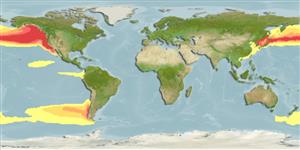>
Stomiiformes (Lightfishes and dragonfishes) >
Stomiidae (Barbeled dragonfishes) > Melanostomiinae
Etymology: Tactostoma: There is two interpretations; Greek, taktos, -e,-on = put in order + Greek, soma = body; or latin, tactus = touch, sense of touch + Greek, soma = body (Ref. 45335).
Environment: milieu / climate zone / depth range / distribution range
Écologie
marin bathypélagique; profondeur 30 - 2000 m (Ref. 28981). Deep-water; 66°N -
Northwest Pacific: Japan (Ref. 559); Kamchatka and Kuril Islands (Ref. 41668). Eastern Pacific: Bering Sea (Ref. 265) and the Gulf of Alaska to southern California, USA (Ref. 2850), southwards to central Baja California (Ref. 35904). Reported from Chile.
Length at first maturity / Taille / Poids / Âge
Maturity: Lm ?, range 30 - ? cm
Max length : 34.3 cm TL mâle / non sexé; (Ref. 4925)
Épines dorsales (Total): 0; Rayons mous dorsaux (Total): 14-18; Épines anales 0; Rayons mous anaux: 19 - 22; Vertèbres: 79 - 82. Jet black all over except for the dark gray on the posterior part of the lower jaw; when the thin epidermis is rubbed off, as is difficult to avoid, the dermis shows lead gray; young rich brown in color (Ref. 6885).
Mesopelagic migrating into epipelagic at night (Ref. 35904). Oviparous, with planktonic eggs and larvae (Ref. 35904).
Eschmeyer, W.N., E.S. Herald and H. Hammann, 1983. A field guide to Pacific coast fishes of North America. Boston (MA, USA): Houghton Mifflin Company. xii+336 p. (Ref. 2850)
Statut dans la liste rouge de l'IUCN (Ref. 130435)
Menace pour l'homme
Harmless
Utilisations par l'homme
Plus d'informations
RéférencesAquacultureProfil d'aquacultureSouchesGénétiqueElectrophoresesHéritabilitéPathologiesTraitementNutrientsMass conversion
CollaborateursImagesStamps, Coins Misc.SonsCiguateraVitesseType de nageSurface branchialeOtolithesCerveauxVision
Outils
Articles particuliers
Télécharger en XML
Sources Internet
Estimates based on models
Preferred temperature (Ref.
123201): 0.3 - 6.7, mean 3.7 °C (based on 150 cells).
Phylogenetic diversity index (Ref.
82804): PD
50 = 1.0000 [Uniqueness, from 0.5 = low to 2.0 = high].
Bayesian length-weight: a=0.00093 (0.00036 - 0.00241), b=3.06 (2.83 - 3.29), in cm total length, based on LWR estimates for this (Sub)family-body shape (Ref.
93245).
Niveau trophique (Ref.
69278): 4.2 ±0.0 se; based on diet studies.
Generation time: 3.3 ( na - na) years. Estimated as median ln(3)/K based on 1
growth studies.
Résilience (Ref.
120179): Milieu, temps minimum de doublement de population : 1,4 à 4,4 années (K=0.3).
Fishing Vulnerability (Ref.
59153): Low to moderate vulnerability (33 of 100).
